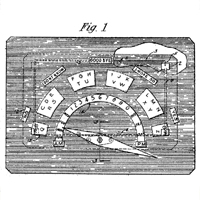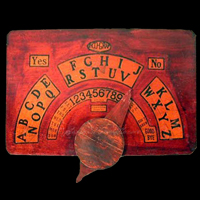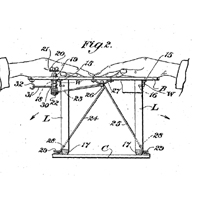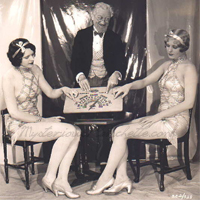Like so many obscure inventors, we have very little biographical information on Grover Haffner, but know a few things about what he spent his life working on. Born in Texas in 1887 but living in Los Angeles by the 1920s, Grover's census date show him to be a chiropractor by trade, and his wife, Marie V., a beauty shop operator.. But it is his first mark on the patent world that brings him into our historical dialogue. Though he would go on to publish a recipe book and invent such items as an improved guitar capo and an attachment for bladed push-mowers to catch grass clippings, it is his foray into the realm of spirit communication that most intrigues us, and for that we know a lot more about!
The "Tipping Table" was patented in 1921, and is yet another in a long line of ouija board take-offs cashing in on a bump in talking board popularity at the time. An early possible incarnation, the "Syco-Graf," is a dial plate board produced by the Auburn Company of Providence, Rhode Island. The board itself is wooden, and sets itself apart by segmenting the usual arched-alphabet design into three sections. The three existing specimens we've seen have a rather low-quality duo-tone stain that is a deep red on the outer board, with a lighter natural stain in the letter and number segments. Rather than the later tipping table mechanism patented by Haffner, it seems that the earlier version of the mechanism relied solely on a ball-bearing design, with a round plate on the indicator for manipulation, and dual indexes--a long one and a short one--for pointing to the two tiers of messages, letters, and numbers
Operation of this dial plate-type operation would be easy enough with just the board and the wheel-planchette, but something happened in the device's design to complicate the mechanism much, much further, with a device hearkening back even to Hare's Spiriticoscopes in their ingenuous mechanism. At what point--if at any--the "Syco-Graf" evolved into its next incarnation is unknown, but as the patent drawings clearly demonstrate, the board's new design has it sitting atop a tall wooden-and-metal framework of springs and pulley-bars. Rather than the users placing their hands on the planchette and spinning it around to spell out answers to questions as in its early designs, users instead place their hands on the board itself, and lateral movement of the board causes the springs and levers underneath to come to life, moving the pointer like the hands of a clock scale.
The mechanism is inspired, though it seems from the rare surviving examples that the bottom framework did not survive intact, and we're lucky to have at least the board tops and wheel planchettes to observe. Early photographs (or is that foto-grafs?) show light, birch-colored boards, and some film stills from a 1920s-era movie even show the Syco-Graf in action, with a wild-haired professor-type character courting two fabulous showgirls with the device, and the device seems to have tipped quite a bit to function properly. This version is absent the wooden disc planchette, now given way to a move traditional clock hand in its place to facilitate the new mechanism for the device. And their discovery in film still is intriguing, as there seems to have been a local Hollywood push to promote the boards, fitting given the location of its origins.
A 1928 edition of Photoplay Magazine, along with a behind-the-scenes promotional still for Tod Browning's lost film London After Midnight that shows the director and Lon Chaney playing with one of the devices, finally exposed many of the lost secrets of the Syco-Graf, though this time clearly re-stamped as the Wanda Tipping Table. This led us to Harry Lang's article, Exposing the Occult of Hocus-Pocus in Hollywood, which features not only a picture of a perfectly intact specimen, but informed us that Haffner's company was by now known as the Wanda Tipping Table Company of Hollywood, which matches the man's location given in his patent information, but casts speculation on the relationship between the East Coast-produced "Syco-Graf" and its West Coast incarnation. According to the article, the items sold quite briskly, and were popular in the Hollywood occult scene of the era. There is more work yet to be done in this intriguing new development, and new discoveries to be made, but until then, we'll keep our eyes peels for one of Haffner's creations -whether it be Wanda or Syco-Graf!










